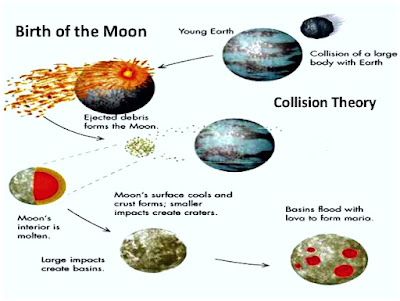Formation of Moon. if you want to learn How Was The Moon Formed? so read and increase the knowledge. read now
How Was The Moon Formed?
Researchers are as yet uncertain concerning how the moon framed, yet the following are three of their smartest options.
The moon framed a hundred million years after the making of the planetary group. This has left researchers considering what was the reason for our planet's satellite to birth in the event that it didn't come from the occasions that development of the planets. Here are only three of the most conceivable clarifications.
Monster Effect Theory
The common hypothesis upheld by established researchers, the goliath influence speculation proposes that the moon framed when an article crushed into early Earth. Like different planets, Earth shaped from the extra dust storm and gas circling the youthful sun. The early planetary group was a brutal spot, and various bodies were made that never come to full planetary status. One of these might have collided with Earth not long after the youthful planet was made.
Known as Theia, the Mars-sized body crashed into Earth, tossing disintegrated pieces of the youthful planet's covering into space. Gravity bound the shot out particles together, making a moon that is the biggest in the nearby planet group comparable to its host planet. This kind of development would make sense of why the moon is made up transcendently of lighter components, making it less thick than Earth the material that framed it came from the hull, while leaving the planet's rough center immaculate. As the material drew together around what was left of Theia's center, it would have focused close to Earth's ecliptic plane, the way the sun goes through the sky, which is where the moon circles today.
As indicated by NASA, "When the youthful Earth and this maverick body impacted, the energy included was 100 million times bigger than the a lot later occasion accepted to have cleared out the dinosaurs."
Albeit this is the most well known hypothesis, it isn't without its difficulties. Most models propose that more than 60%of the moon ought to be comprised of the material from Theia. Be that as it may, rock tests from the Apollo missions propose in any case.
"As far as organization, the Earth and moon are nearly twins, their sytheses contrasting by all things considered not many parts in 1,000,000," Alessandra Mastrobuono-Battisti, an astrophysicist at the Israel Foundation of Innovation in Haifa, told Space.com. "This logical inconsistency has stirred up misgivings about the monster influence model."
In 2020 examination distributed in Nature Geoscience(opens in new tab), offered a clarification with regards to why the moon and Earth have such comparative organization. Having concentrated on the isotopes of oxygen in the moon rocks brought to Earth from Apollo space explorers, specialists found that there is a little contrast when contrasted and Earth rocks. The examples gathered from the profound lunar mantle (the layer beneath the outside) were a lot heavier than those tracked down on The planet and "have isotopic creations that are generally illustrative of the proto-lunar impactor 'Theia'", the review creators composed.
Back in 2017, Israeli scientists proposed an elective effect theory(opens in new tab) which recommends that a downpour of little trash fell on Earth to make the moon.
"The various effect situation is a more normal approach to making sense of the development of the moon," Raluca Rufu, a specialist at the Weizmann Foundation of Science in Israel and lead creator of the review, told Space.com. "In the beginning phases of the nearby planet group, influences were exceptionally bountiful; subsequently, it is more regular that few normal impactors framed the moon, as opposed to one unique one.
CO-Development Hypothesis
Moons can likewise frame simultaneously as their parent planet. Under such a clarification, gravity would have made material in the early nearby planet group draw together simultaneously as gravity bound particles together to shape Earth. Such a moon would have a very much like sythesis to the planet, and would make sense of the moon's current area. Be that as it may, in spite of the fact that Earth and the moon share a significant part of a similar material, the moon is considerably less thick than our planet, which would likely not be the situation if both began with similar weighty components at their center.
In 2012, specialist Robin Canup, of the Southwest Exploration Organization in Texas, suggested that Earth and the moon framed simultaneously when two huge items multiple times the size of Mars collided with one another.
"In the wake of impacting, the two comparable estimated bodies then re-impacted, framing an early Earth encompassed by a plate of material that consolidated to shape the moon," NASA said. "The re-crash and ensuing consolidation left the two bodies with the comparable synthetic sytheses seen today.
Catch Hypothesis
Maybe Earth's gravity caught a passing body, as occurred with different moons in the nearby planet group, like the Martian moons of Phobos and Deimos. Under the catch hypothesis, a rough body shaped somewhere else in the nearby planet group might have been brought into space around Earth. The catch hypothesis would make sense of the distinctions in the sythesis of Earth and its moon. Nonetheless, such orbiters are frequently strangely molded, instead of being round bodies like the moon. Their ways don't will generally agree with the ecliptic of their parent planet, additionally dissimilar to the moon.
Albeit the co-development hypothesis and the catch hypothesis both make sense of certain components of the presence of the moon, they leave many inquiries unanswered. As of now, the monster influence speculation appears to cover a considerable lot of these inquiries, making it the best model to fit the logical proof for how the moon was made.













1 Comments